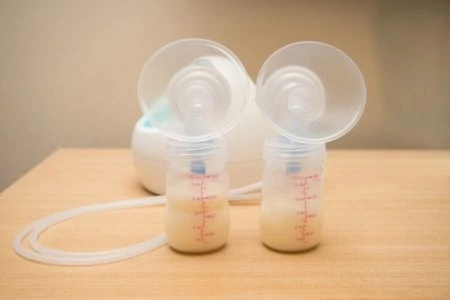One of the most common questions new mothers ask us is exactly how long a breastfeeding session should last.
We all love the snuggle time with our little ones, but let’s be honest; it is stressful wondering if you can get anything else done when the feeding duty falls entirely on your shoulders.
If you are staring at the clock and wondering if your nursing sessions are normal, we have the answers. We will break down average times, frequency, and how busy moms can make the most of every feed.
Key Takeaways
- Breastfeeding sessions typically last between 20 and 45 minutes, though newborns often take longer.
- Newborns nurse frequently, usually 8 to 12 times a day, to build your milk supply.
- Watch your baby for cues, not the clock; look for relaxed hands and a “milk-drunk” appearance to know they are full.
- Cluster feeding is a normal behavior where babies want to eat constantly for a few hours, often before a long sleep.
Baby Milk Intake Requirements
At birth, babies have tiny stomachs roughly the size of a cherry. They generally take only one to two ounces of milk per feeding. As their stomach grows, so does their appetite.
Most babies reach peak feeding capacity around five weeks, taking three to four ounces per session. Your baby should maintain this intake level until they are ready for solid foods.
If you have formula-fed a baby before, these numbers might seem low. However, breastfed babies generally consume less milk per feeding than formula-fed babies because breast milk is digested more efficiently.
Typical Breastfeeding Frequency
Babies do best when fed on demand. This means you set your schedule based on their hunger rather than a clock. You want to follow your child’s lead and watch for cues that they are ready to nurse.
Every child is different, but general guidelines help you know what to expect. Newborns generally nurse every one to three hours, which totals about eight to 12 times a day. As your baby grows, they will likely feed every four hours until you start weaning (1). However, remember that some babies simply prefer to snack more frequently.
It is normal for babies to go through periods of cluster feeding, where they want to nurse constantly over a few hours. A baby will often cluster feed right before a long stretch of sleep or when waking up from a long nap.
Growth spurts also cause your baby to nurse more often for a couple of days. This frequent removal of milk naturally boosts your supply to meet their growing needs. These spurts tend to happen when your baby is approximately 3 weeks, 6 weeks, 9 weeks, 3 months, 6 months, and 9 months old.
Average Duration of Breastfeeding Sessions
A single breastfeeding session can take between 20 and 45 minutes, especially during the newborn period when they are still learning the ropes. However, each baby is unique. It is important not to stop them from feeding too early just because a timer went off.
Your baby has a great sense of how much milk they need. Watch their body language rather than the clock. When they look sleepy, their hands are relaxed, and they have stopped active sucking for a few minutes, there is a good chance they are full.
Switching Sides During Feeds
Most experts recommend offering both breasts during a single breastfeeding session. When your baby finishes feeding from one breast, burp them and switch them over to the other.
Think of the second breast as “dessert.” They may take it, or they may be too full. As long as you have not stopped feeding from the first breast prematurely, it is perfectly fine if they refuse the second side.
Nursing your baby on both sides benefits you by preventing engorgement and stimulating milk production equally. Babies who struggle to gain weight benefit significantly from being offered both breasts at every feeding to maximize calorie intake.
Waking a Sleeping Newborn
New babies love to sleep. But is it wise to wake them up when they haven’t nursed for hours?
The answer is yes; strictly if your baby is younger than five weeks old (2). As much as you might be excited for the quiet time, you must wake them every two to three hours to nurse to ensure they regain their birth weight. Once they pass the four-week mark and are growing well, you can usually let them sleep until they wake up naturally.
Tips for Comfortable Breastfeeding
Breastfeeding is not always easy, especially in the beginning when you are nursing constantly. When settling down for a 45-minute session multiple times a day, you might get bored or physically uncomfortable.
Here are five easy tips to make nursing a better experience for you both:
1. Establish a Proper Latch
A good latch is essential for your baby to get milk efficiently and to prevent pain for you. When your baby latches correctly, they will have most or all of your areola (not just the nipple) in their mouth.
With a proper latch, you should not experience pinching pain. You should hear rhythmic swallowing sounds without any clicking noises.
2. Find Your Position
There are many positions to hold your baby in while you nurse. Experiment to find one that works for your body shape.
Some positions allow you to sit comfortably in public, while others let you lounge in your bed at night.
These are the essentials for a supported nursing position:
- Turn your baby’s body fully toward you; their ear, shoulder, and hip should be in a straight line.
- Hold your baby snug against you with no gap between your stomach and their body.
- Ensure your back and arms are well-supported with pillows.
3. Invest in a Comfortable Chair
A dedicated nursery glider or rocker is a game-changer. Since you will spend hours here, you want something sturdy and supportive.
We suggest looking for a chair with plush cushioning, armrests, and a place to put your feet up. A swivel feature is also helpful for grabbing water or your phone without disturbing the baby.
4. Prioritize Rest and Hydration
Whether your breastfeeding session is long or short, you need to relax. Stress can negatively impact your milk production and let-down reflex (3).
Create a “nursing station” with water, snacks, and a phone charger nearby. Use the time you breastfeed to bond with your little one or simply zone out.
5. Use Clothing as a Tool
If you are eager to get out of the house, do not let breastfeeding keep you trapped inside. You can go about your daily life and breastfeed wherever you go with the right gear.
There are nursing bras, fabric covers, and dresses designed specifically for easy access. Even without special clothes, the “two-shirt method” (wearing a tank top under a loose shirt) makes nursing in public discreet and easy.
Identifying Hunger Cues
Your baby will let you know loudly when they are starving. However, you can save your ears some trauma by watching for early signs that they are ready to nurse.
Look for these subtle signals before the crying starts:
- Smacking lips or licking motions.
- Rooting (turning head) or reaching for your chest.
- Fidgeting, squirming, or looking alert.
- Sucking on hands, fingers, or toys.
If your baby is crying, they are likely already “hangry.” Crying is a late sign of hunger and makes latching difficult because the baby is distressed. Calm them down first, then offer the breast.
FAQs
Your Breastfeeding Experience
Breastfeeding sessions are unique to every baby. Some are efficient speed-eaters, while others love to linger and cuddle. As long as they are gaining weight and making dirty diapers, try not to stress over the minutes on the clock. With patience, you will find a natural rhythm that works for both of you.
Think about your own eating habits. Are all your meals evenly spaced around the clock? Do they all take the same amount of time? Your baby will likely feed at uneven intervals for varying amounts of time. Learning to judge when and how long is all part of parenting your new little bundle.
Editor's Note:
Michelle Roth, BA, IBCLC












